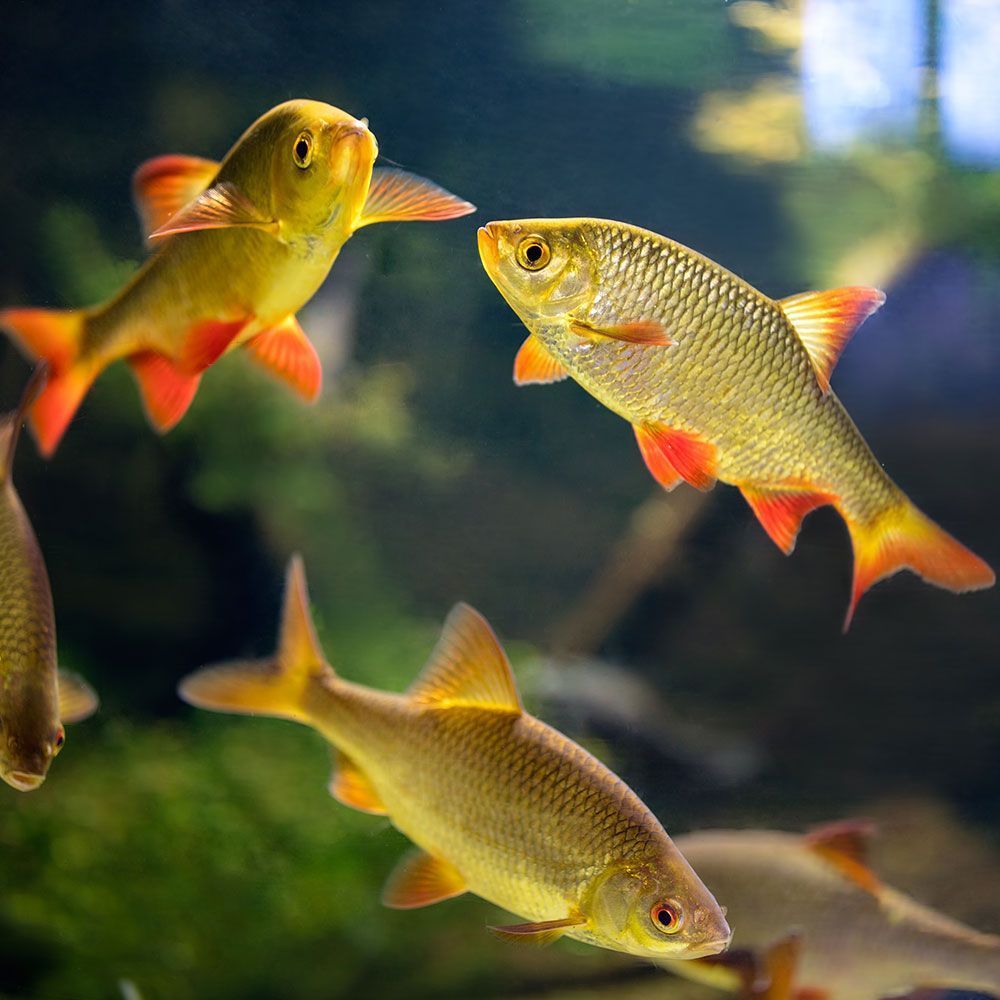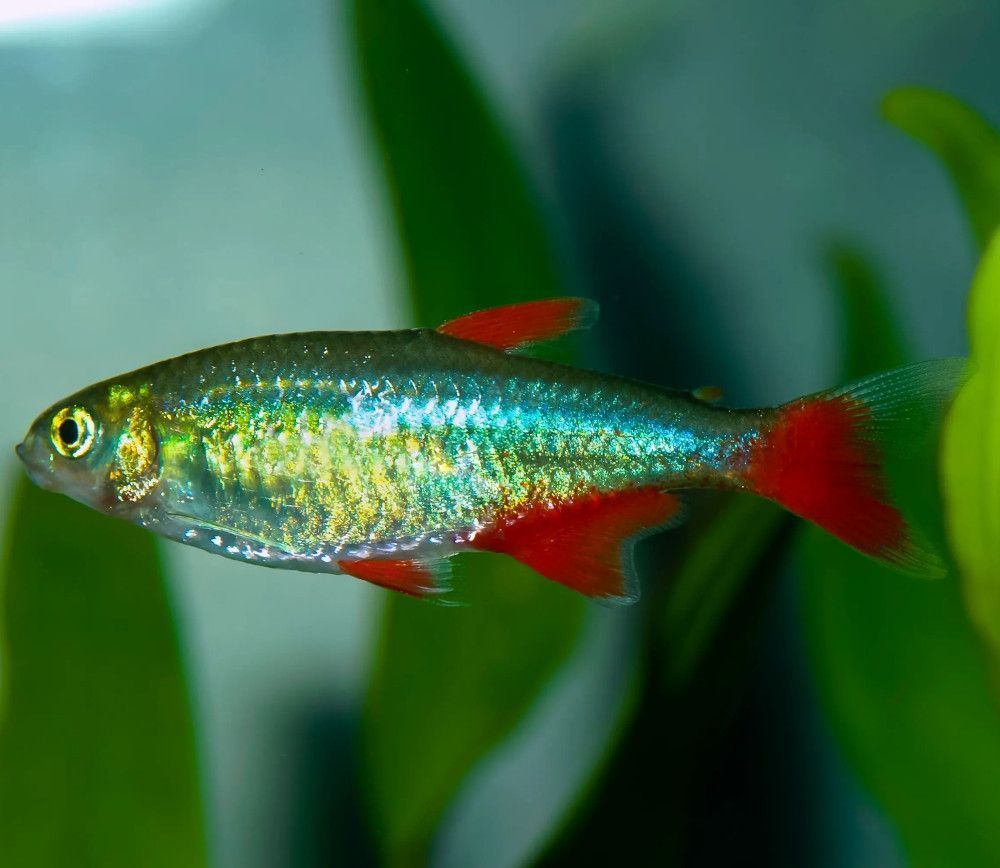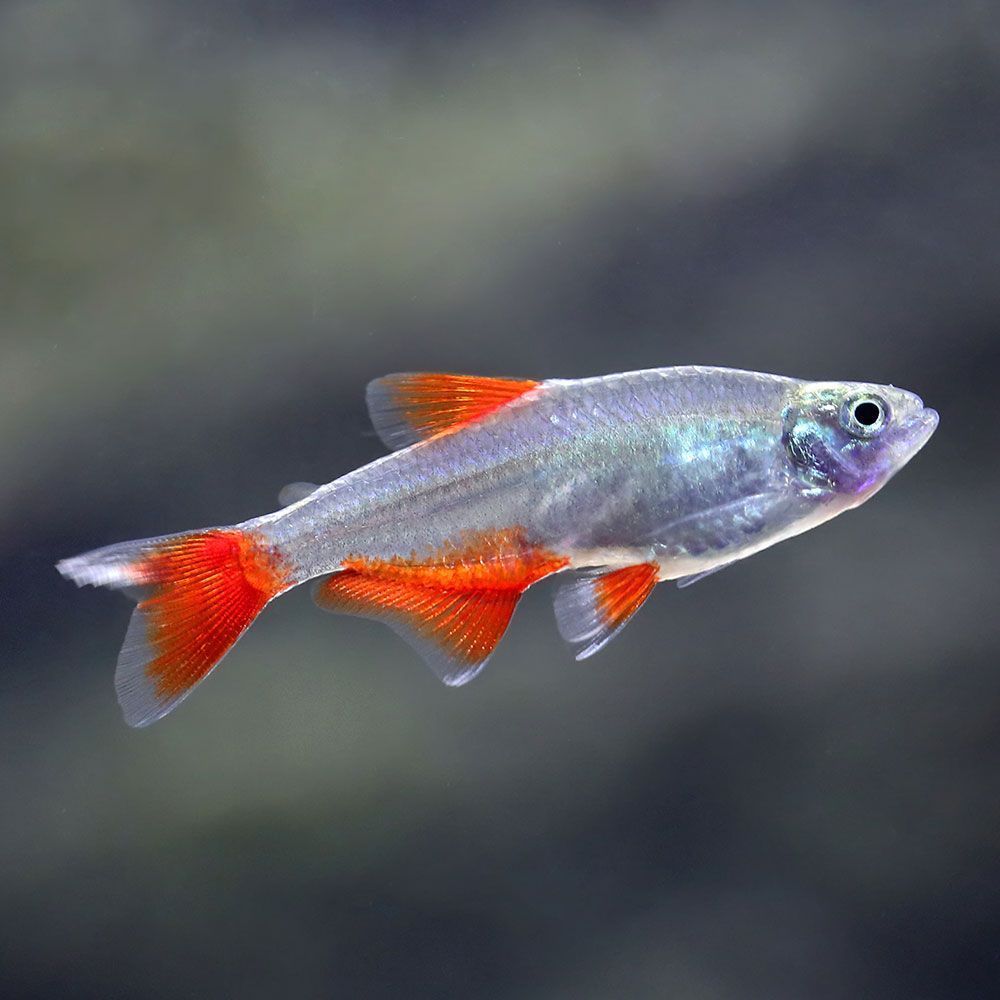If you want a hint of a colorful wave to your tank, bloodfin tetra is the best choice. The species is easy to care for, making it an outstanding choice for beginners.
It is peaceful but not shy; it loves to explore the tank and playfully swim around with its group. When observed from afar, the group looks like a floating vibrant-colored sheet.
So, if you’re curious about this, keep reading!
What is a Bloodfin Tetra?
Bloodfin tetra are freshwater fish which are characterized by their red or blood color fins. They are also playful and friendly fish that live in groups. Let us understand more about them below:
| Origin | Basins of Paraná River, South America |
| Order | Characiformes |
| Family | Chacidae |
| Scientific Name | Aphyocharax anistisi |
| Common Names | Bloodfin tetra, true bloodfin and redfinned tetra |
| IUCN Red List Status | Not Evaluated |
| Appearance | Silvery body and red tail and fins other than the pectoral one |
| Size | Up to 5.0 cm (2.0 in) |
| Lifespan | 5-8 years |
| Temperament | Peaceful, shoaling fish |
| Tank Level | Top to middle dwellers |
| Water Temperature | 65-82 °F (18-28 °C) |
| pH Level | 6.5-7.5 |
| Water Hardness | 6-15 dGH |
| Care Level | Easy |
| Minimum Tank Size | 25 gallons for 8 of the same species |
| Tank Environment | Vegetated tank with plenty of space to swim, hide, and rest |
| Diet | Omnivorous |
| Tank Mates | Peaceful, similar-sized species that don’t have long fins |
What is the Natural Habitat for Bloodfin Tetra?
The species is naturally found in the Paraná River basins in Argentina, Bolivia, Brazil, Paraguay, and Uruguay of South America.
It prevails in the benthopelagic zone or upper and middle water levels of tropical freshwater. There it feasts on crustaceans, small insects, and worms.
Which family do Bloodfin Tetra belong?
The fish belongs to the family Chacidae under the order Characiformes. It is scientifically known as Aphyocharax anistisi.
But otherwise, it is popular in the aquarium culture by the following names:
- Bloodfin tetra
- Redfinned tetra
- True bloodfin
- Bloodfin
It also has various local names like
- Pyku and Pequira (Argentina)
- Cauda vermelha and Lambari (Brazil)
Fun Fact: In the presence of a predator, this fish fades the red color of its fins to be less conspicuous.
How do Bloodfin Tetra look?

Like most tetras, bloodfin tetra fish looks oval and bilaterally symmetric.
What is the Size of Bloodfin Tetra?
The average adult fish is about 5.0 cm (2 in) long.
What is the Color of Bloodfin Tetra?
The body of the fish is silver white, its tail and fins (dorsal, anal, adipose, caudal, and pelvic) are red and the pectoral fins are colorless.
But depending on diet, maintenance, stress levels, and other conditions, the intensity of the red color may vary.
What are the Features of Bloodfin Tetra?
The fish is torpedo-shaped and is thicker near its head and middle body. Later on, its shape becomes slimmer as you go near the back.
It has large eyes with a black band surrounding its iris. This band reduces glare and helps it see better in bright places.
It has a 200-2000 Hz hearing range and a 70 dB hearing threshold.
The fish has mineralized skeletal tissue containing aragonite and hydroxylapatite, and its skeleton contains apatite.
What is the difference between a male Bloodfin Tetra and a female one?
The male fish has a streamlined body, and the female fish is rounder. The male fish may have small hooks on its pelvic, anal fins and gill glands.
You can guess the male fish’s maturity stage from the number of hooks on its anal fins and the gill glands frequency.
During spawning season, males show a brighter color, and females become plumper.
How do Bloodfin Tetra behave?
This is a peaceful species and hardly ever initiates fights. It isn’t territorial and feels more comfortable in a group of conspecifics (own species).
It rather feels intimidated by other bigger, lively, and more aggressive fish.
What is the Lifespan of Bloodfin Tetra?
Usually, in captivity, the fish lives for 5 to 8 years. This is because it’s hard to maintain the best conditions perfectly. But pro aquarists can sustain them longer until 10 years.
Author’s Note: Always keep them in large shoals or groups. Otherwise, they might get stressed and show fin-nipping behavior to other species with long fins.
How to take care of Bloodfin Tetra?

If you want your tiny-little water buddy to stay with you for the longest, here are a few things to remember.
What Tank Size is recommended for Bloodfin Tetra?
You need a 25 gallons tank to house 8 of the same species. Get a bigger tank if you will house more bloodfins or other tank mates. For every extra bloodfin tetra you add, make sure you add at least 3 gallons of water.
What Water Chemistry is good for Bloodfin Tetra?
To upkeep the health of your fish, maintain the best water parameters as suggested below.
- pH Levels: 6.5-7.5
- Water Temperature: 65-82 °F (18-28 °C)
- Water Hardness: 6-15 dGH
- Ammonia: 0 ppm
- Nitrite: 0 ppm
- Nitrate: Below 20 ppm
What is the Tank Environment for Bloodfin Tetra?
You can further diminish possible stress for the fish by creating a suitable environment in the tank. For that, try to abide by these rules.
Is Substrate needed in an aquarium with Bloodfin Tetra?
Any kind of substrate can work, but it prefers dark river sand substrate. It keeps the tank darker and allows them to explore. It also makes the fish even more noticeable.
Do you need Plants with Bloodfin Tetra?
Add plants to cover it from direct lighting. For example, Java moss, Anubias, and Amazon swords work well.
What type of Lighting is needed for Bloodfin Tetra?
Use dim lights to prevent the fish from getting stressed. As a result, it also helps in showing its best colors.
What is the Décor required for Bloodfin Tetra?
Add driftwood, twisted roots, and caves to create hiding spots. Put in dried (beech or oak) leaves to stain the water with tannins and increase acidity. But regularly change the leaves and branches to avoid rotting.
What type of filter is needed for Bloodfin Tetra?
Use a sponge filter so that the pump won’t suck the eggs or fry even if they spawn.
What is the Water Flow Rate needed for Bloodfin Tetra?
Maintain a slow-moving water flow rate like its wild habitat.
Fish Care Tip: The fish often jumps out of the water to catch insects and escape predators in the wild. To prevent that, you must keep your tank tightly covered and have enough space between the water surface and the lid.
What do Bloodfin Tetra eat?
The fish isn’t fussy with food at all and enjoys varied food. Feed them multiple times daily, and each meal will be for 3 minutes only. You can feed your pet fish:
- High-quality flakes
- Pellets
- Bloodworms
- Brine shrimp
- Frozen fish food
- Daphnia
- Cyclops
- Small insects
- Crustaceans
- Tubifex
What are the Tank Mates for Bloodfin Tetra?
Since it is a shoaling fish, it must always be in a group of 8 (minimum). You can add more if you want. Other than that, its best tank mates are similar-sized species with peaceful temperaments. Some are:
- Similar-sized tetras (black skirt tetra, snowlight tetra, rosy tetra, neon tetra, cardinal tetra, green neon tetra, ember tetra)
- Southern platyfish
- Danios (Zebra danio)
- Corys
- Rainbowfish
- Rasboras (Harlequin rasbora)
- Silver dollars
- Cherry barb
- Cyprinids
- White cloud mountain minnow
- Small loricariids
- Swordtails
- Snails
- Peaceful and similar-sized shrimps (Ghost shrimp, Amano shrimp)
- Crabs
- Small gouramis (Dwarf gourami, Pearl gourami)
- Gentle plecos (Bristlenose pleco, Rubber lip pleco)
Which Tank Mates to Avoid keeping with Bloodfin Tetra?
Don’t put this fish in a community tank with boisterous fish like,
- Large gouramis (Kissing gourami, Paradise gourami)
- Large cichlids (Jewel, Red devil, Wolf, Umbee, and Jaguar cichlids)
- Oscars
- Flowerhorns
Some tank mates that may be endangered because of bloodfin tetra are:
- Fish with long fins: Bloodfins rarely show nipping behavior. So, if they do, fishes with long fins will be attacked first.
- Small crustaceans: The fish may gulp them down.
What are the Common Diseases for Bloodfin Tetra?
In general, this species is pretty hardy and disease resistant. But it’s always wise to be aware of these and keep your buddy healthy and happy:
| Disease Name | Causes | Symptoms | Treatment |
|---|---|---|---|
| Ich | Protozoan parasite | White spots, flashing, fatigue, appetite loss | Temperature elevation in the aquarium, adding ich medicine or aquarium salt |
| Fin rot | Bacterial infection | Fin disintegrating or fraying, fin discoloration or red streaks on the fin, fatigue, appetite loss | Water quality improvement, removal of physical injury sources, antibiotics |
| Columnaris | Bacterial infection | Grey or white patches on the body, fin fraying, fatigue, appetite loss | Water quality improvement, antibiotics, stress reduction |
| Velvet | Parasitic infection | Flashing, color loss, rapid breathing, clamped fin against the body, fatigue, appetite loss, yellowish film on the skin, skin peeling | Water temperature elevation, keeping lights dimmer for days, add aquarium salt or medicine containing malachite green or aldehyde |
| Skin flukes | Parasitic infection | Red spots, scale loss, excess mucus, flashing. fatigue, appetite loss | Oral medicines, medicated baths, injections |
| Neon tetra disease | Microsporidian parasite | Color loss, lumpy flesh, restlessness, swimming troubles, curved spine, fin rot, bloating | Incurable But try using methylene blue |
| Hexamita | Protozoan parasite | Red feces, hemorrhage around the head, color loss, appetite loss | Immediate antifungal treatment |
| Epistylis | False fungal infection | Flashing, appetite loss, fatigue, small white raised dots, white powder, fuzzy patches, | Lower water temperature by 5-8 degrees, 20-30% water change every 3 days, medicine |
| Mycobacteriosis | Bacterial infection | Skin sores, scale loss, breeding troubles, appetite loss, fatigue | Incurable. Decontaminate the tank and disinfect fish |
Quick Tip: Feed your fish home-cultivated live feed to avoid exposure to parasites.
How to Breed Bloodfin Tetra?
The fish is pretty easy to breed, and you can induce them to reproduce in your tank. For successful breeding, you must follow what’s written below:
How should you keep a male and female Bloodfin Tetra for breeding?
Separate males and females in two different tanks such that they can see each other. Feed them quality-grade food (dry, flakes, frozen, and live feed) thrice a day.
How to prepare a Breeding Tank for Bloodfin Tetra?
In a 15-gallon tank, add a sponge filter for a gentle water flow rate. Add breeding mops in the bottom and dim lighting with the following water parameters:
- Temperature: 72-80 °F (22-27 °C)>
- pH: 6.5-6.8>
How to Spawn Bloodfin Tetra?
Introduce a group or an equal number of males and females during the evening. Choose the brightest colored males and plumpest females from the lot.
By the following day, they must have spawned.
How many eggs does Bloodfin Tetra lay?
The female fish scatters about 300-500 eggs over the spawning mops.
Remove parent fish after the eggs are laid, as they may eat their fries.
When do Bloodfin Tetra eggs hatch?
In the best conditions, the eggs hatch after 24 hours. Otherwise, it may take a few more days. The fries consume their yolk sac as they free themselves.
When the fries slowly start swimming freely, feed them powdered fry food or infusoria. Feed them baby brine shrimp only after they grow a bit more.
Breeding Tip: The female fish may often jump out from the water while laying eggs as the species is an egg scatterer. So, keep a tight lid on.
What to keep in mind while buying Bloodfin Tetra?
In my experience, some sellers confuse bloodfin tetra and glass bloodfin tetra even though they are different species. The latter has no red anal and ventral fin. So, observe closely before buying the fish.
A word from FishInAquarium
The bloodfin tetra can adapt to a wide range of temperatures. So, you can house it with various compatible tank mates and build a unique aquascape. It is also inexpensive, so you can easily invest in a big school!
If you have all your answers, don’t forget to share this fish guide with fellow enthusiasts.
Lastly, if there’s any query, don’t be shy to mail us. We promise to reach out with solutions!


